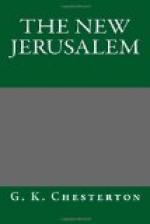But if the purpose of the camp be appropriate to the story of St. George, the position of the camp might be considered appropriate to the more fantastic story of St. George and the Dragon. The symbolic struggle between man and monster might very well take place somewhere where the green culture of the fields meets the red desolation of the desert. As a matter of fact, I dare say, legend locates the duel itself somewhere else, but I am only making use of the legend as a legend, or even as a convenient figure of speech. I would only use it here to make a kind of picture which may clarify a kind of paradox, very vital to our present attitude towards all Palestinian traditions, including those that are more sacred even than St. George. This paradox has already been touched on in the last chapter about polytheistic spirits or superstitions such as surrounded the Old Testament, but it is yet more true of the criticisms and apologetics surrounding the New Testament. And the paradox is this; that we never find our own religion so right as when we find we are wrong about it. I mean that we are finally convinced not by the sort of evidence we are looking for, but by the sort of evidence we are not looking for. We are convinced when we come on a ratification that is almost as abrupt as a refutation. That is the point about the wireless telegraphy or wordless telepathy of the Bedouins. A supernatural trick in a dingy tribe wandering in dry places is not the sort of supernaturalism we should expect to find; it is only the sort that we do find. These rocks of the desert, like the bones of a buried giant, do not seem to stick out where they ought to, but they stick out, and we fall over them.
Whatever we think of St. George, most people would see a mere fairy-tale in St. George and the Dragon. I dare say they are right; and I only use it here as a figure for the sake of argument. But suppose, for the sake of argument, that a man has come to the conclusion that there probably was such a person as St. George, in spite of all the nonsense about dragons and the chimera with wings and claws that has somehow interwreathed itself with his image. Perhaps he is a little biased by patriotism or other ethical aims; and thinks the saint a good social ideal. Perhaps he knows that early Christianity, so far from being a religion of pacifists, was largely a religion of soldiers. Anyhow he thinks St. George himself a quite sufficiently solid and historical figure; and has little doubt that records or traces can be found of him. Now the point is this; suppose that man goes to the land of the legendary combat; and finds comparatively few or faint traces of the personality of St. George. But suppose he does find, on that very field of combat, the bones of a gigantic monster unlike every other creature except the legendary dragon. Or suppose he only finds ancient Eastern sculptures and hieroglyphics representing maidens, being sacrificed to such a monster, and making




